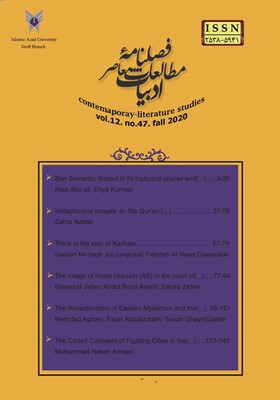-
-
List of Articles
-
Open Access Article
1 - Bon Semantic School in its historical course and analysis of its principles based on Izutsu's opinions and its application in the Holy Quran
Raja Abo ali Ehya Komasi -
Open Access Article
2 - Metaphorical images in the Qur'an; Psychological effects and their elements
Zahra Nadali -
Open Access Article
3 - Thirst in the epic of Karbala
Saeideh Mir Hagh Joo Langroudi Fatemeh Ali Nejad Chamazkati -
Open Access Article
4 - The image of Imam Hussein (AS) in the court of Jamal al-Din Khaliei
Massoud Jaber Abdul Reza Atashi Sahad Jaderi -
Open Access Article
5 - The Reverberation of Eastern Mysticism and the Reverberation of Western Surrealism in the Poetry of Sohrab Sepehri
Mehrdad Aghaei Fazel Abbaszadeh Susan Ghayebzadeh -
Open Access Article
6 - The Coded Concepts of Fighting Cities in the Resistance Poetry of Mohammad Darvish
Mohammad Hasan Amraei
-
The rights to this website are owned by the Raimag Press Management System.
Copyright © 2021-2025







